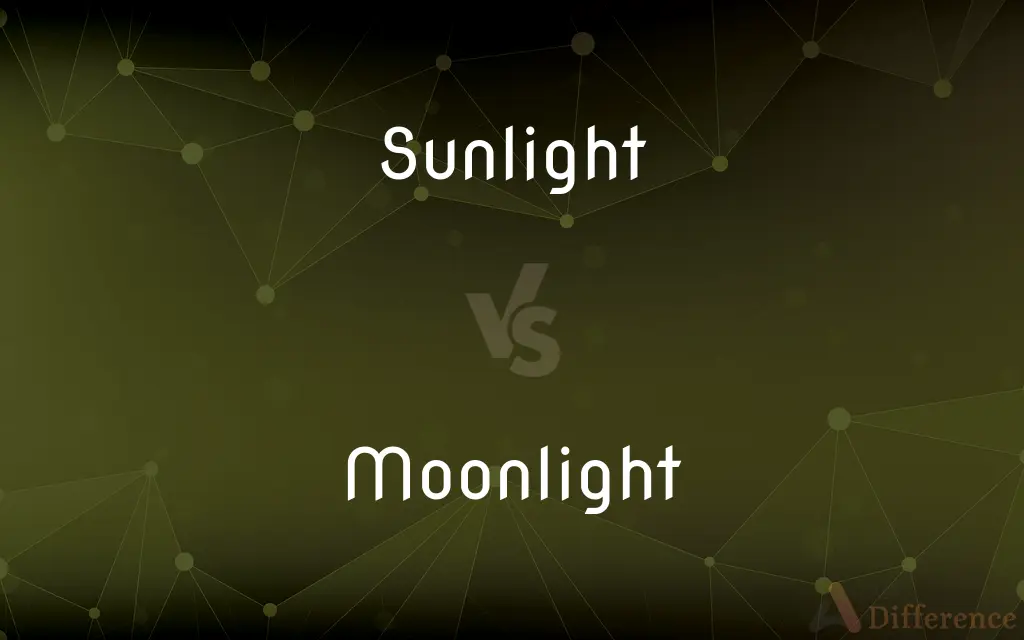Sunlight vs. Moonlight — What's the Difference?
By Tayyaba Rehman & Fiza Rafique — Updated on March 14, 2024
Sunlight is direct emission from the sun, vital for life and energy, whereas moonlight is reflected sunlight from the moon's surface, softer and less intense.

Difference Between Sunlight and Moonlight
Table of Contents
ADVERTISEMENT
Key Differences
Sunlight is the direct light that we receive from the Sun, which includes a broad spectrum of electromagnetic radiation. It's essential for photosynthesis in plants, influencing Earth's climate and weather, and is a primary source of energy for all living organisms. On the other hand, moonlight is the light that reaches Earth after being reflected off the Moon's surface. It's much dimmer than sunlight, does not support photosynthesis, and has a different impact on the behavior of many animals and plants.
While sunlight is intense and can illuminate the Earth's surface enough to support various forms of life, moonlight, being reflected sunlight, is much weaker. This difference in intensity affects how both types of light influence biological rhythms and behaviors in the animal kingdom. For example, some animals are diurnal, active during the day under sunlight, whereas others are nocturnal, becoming active under the cover of moonlight.
Sunlight provides a spectrum that includes visible light, ultraviolet (UV) light, and infrared (IR) light, which are crucial for various biological processes. Whereas, the spectrum of moonlight, being reflected sunlight, is similar but significantly less in intensity, and the UV and IR components are much reduced, affecting its impact on the environment.
The psychological effects of sunlight and moonlight also differ significantly. Sunlight is often associated with warmth, growth, and happiness, and can influence human mood and well-being. In contrast, moonlight is associated with calmness, tranquility, and is often used in cultural contexts to symbolize mystery or romance.
Despite their differences, both sunlight and moonlight have been central to human culture, art, and literature, each symbolizing various concepts and emotions. While sunlight is often a symbol of clarity, energy, and life, moonlight typically represents mystery, serenity, and contemplation.
ADVERTISEMENT
Comparison Chart
Source
Direct from the Sun
Reflected light from the Moon
Intensity
Bright and strong, capable of supporting life
Much dimmer, soft glow
Spectrum
Includes visible, UV, and IR light
Similar to sunlight but reduced in intensity
Biological impact
Supports photosynthesis, affects circadian rhythms
Influences nocturnal behaviors, has less impact on photosynthesis
Cultural symbolism
Often associated with life, growth, and energy
Symbolizes mystery, romance, and tranquility
Compare with Definitions
Sunlight
Direct light from the Sun.
Sunlight is crucial for photosynthesis in plants.
Moonlight
Reflected sunlight from the Moon.
Moonlight bathes the night in a soft glow.
Sunlight
Symbol of clarity and life.
Artists often use sunlight to symbolize hope in their paintings.
Moonlight
Less intense, without supporting photosynthesis.
Moonlight is not strong enough to trigger photosynthesis.
Sunlight
Visible, UV, and IR spectrum.
Sunlight exposure is important for vitamin D synthesis.
Moonlight
A dim, softer light at night.
The path was illuminated by the gentle moonlight.
Sunlight
A source of energy and warmth.
The greenhouse uses sunlight to warm its interior.
Moonlight
Influencer of nocturnal behavior.
Many predators hunt by moonlight.
Sunlight
Influencer of Earth's climate.
Sunlight variations can lead to changes in weather patterns.
Moonlight
Symbol of mystery and tranquility.
Moonlight often represents romance in literature.
Sunlight
Sunlight is a portion of the electromagnetic radiation given off by the Sun, in particular infrared, visible, and ultraviolet light. On Earth, sunlight is scattered and filtered through Earth's atmosphere, and is obvious as daylight when the Sun is above the horizon.
Moonlight
Moonlight consists of mostly sunlight (with little earthlight) reflected from the parts of the Moon's surface where the Sun's light strikes.
Sunlight
Light from the sun
A shaft of sunlight
Moonlight
The light reflected from the surface of the moon.
Sunlight
The light of the sun; sunshine.
Moonlight
To work at another job, often at night, in addition to one's full-time job.
Sunlight
All the electromagnetic radiation given off by the Sun, especially that in the visible spectrum that bathes the Earth.
Sunlight on the skin gives you vitamin D.
Moonlight
The light reflected from the Moon.
Sunlight
(figuratively) Brightness, hope; a positive outlook.
Moonlight
To work on the side (at a secondary job), often in the evening or during the night.
Sunlight
Synonym of sunrise.
Moonlight
(by extension) To engage in an activity other than what one is known for.
Sunlight
To work on the side (at a secondary job) during the daytime.
Moonlight
To carry out undeclared work.
Sunlight
The light of the sun.
Moonlight
The light of the moon.
Sunlight
The rays of the sun;
The shingles were weathered by the sun and wind
Moonlight
To work at a second job in addition to one's main occupation; - often done at night.
Moonlight
The light of the moon;
Moonlight is the smuggler's enemy
The moon was bright enough to read by
Moonlight
Work a second job, usually after hours;
The law student is moonlighting as a taxi driver
Common Curiosities
What is sunlight?
Sunlight is the direct light emitted by the Sun, encompassing a broad spectrum of electromagnetic radiation.
How does sunlight affect plants?
Sunlight is essential for photosynthesis, the process by which plants produce energy.
Can moonlight support photosynthesis?
No, moonlight is too dim to support photosynthesis in plants.
What is moonlight?
Moonlight is the light that reaches Earth after being reflected from the Moon's surface.
Can moonlight affect animal behavior?
Yes, moonlight can influence the behavior of nocturnal animals and their biological rhythms.
How does sunlight influence human health?
Sunlight exposure is necessary for vitamin D synthesis and can influence mood and well-being.
Is moonlight just reflected sunlight?
Yes, moonlight is sunlight that has been reflected off the Moon's surface.
How does the spectrum of sunlight and moonlight differ?
The spectrum is similar, but moonlight lacks the intensity and the full spectrum of sunlight, especially in UV and IR light.
What psychological effects can sunlight have?
Sunlight can improve mood and energy levels, being associated with happiness and well-being.
What psychological effects can moonlight have?
Moonlight is often associated with calmness, mystery, and can have a tranquil effect.
How does sunlight affect the Earth's climate?
Sunlight is a key factor in Earth's climate and weather patterns, influencing temperatures and weather conditions.
Can the intensity of sunlight and moonlight vary?
Yes, the intensity of sunlight can vary based on time of day and weather conditions, while moonlight's intensity varies with the lunar cycle.
Why is sunlight brighter than moonlight?
Sunlight is direct radiation from the Sun, while moonlight is sunlight reflected from the Moon, resulting in much lower intensity.
Are there cultural differences in how sunlight and moonlight are perceived?
Yes, cultures around the world have various symbols and meanings associated with both sunlight and moonlight.
How is moonlight used in literature and art?
Moonlight is often used to symbolize romance, mystery, and tranquility in both literature and art.
Share Your Discovery

Previous Comparison
Nice vs. Fine
Next Comparison
Fascist vs. DictatorAuthor Spotlight
Written by
Tayyaba RehmanTayyaba Rehman is a distinguished writer, currently serving as a primary contributor to askdifference.com. As a researcher in semantics and etymology, Tayyaba's passion for the complexity of languages and their distinctions has found a perfect home on the platform. Tayyaba delves into the intricacies of language, distinguishing between commonly confused words and phrases, thereby providing clarity for readers worldwide.
Co-written by
Fiza RafiqueFiza Rafique is a skilled content writer at AskDifference.com, where she meticulously refines and enhances written pieces. Drawing from her vast editorial expertise, Fiza ensures clarity, accuracy, and precision in every article. Passionate about language, she continually seeks to elevate the quality of content for readers worldwide.















































